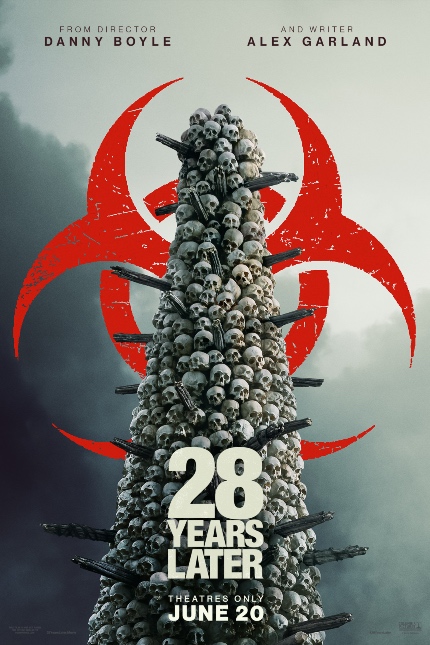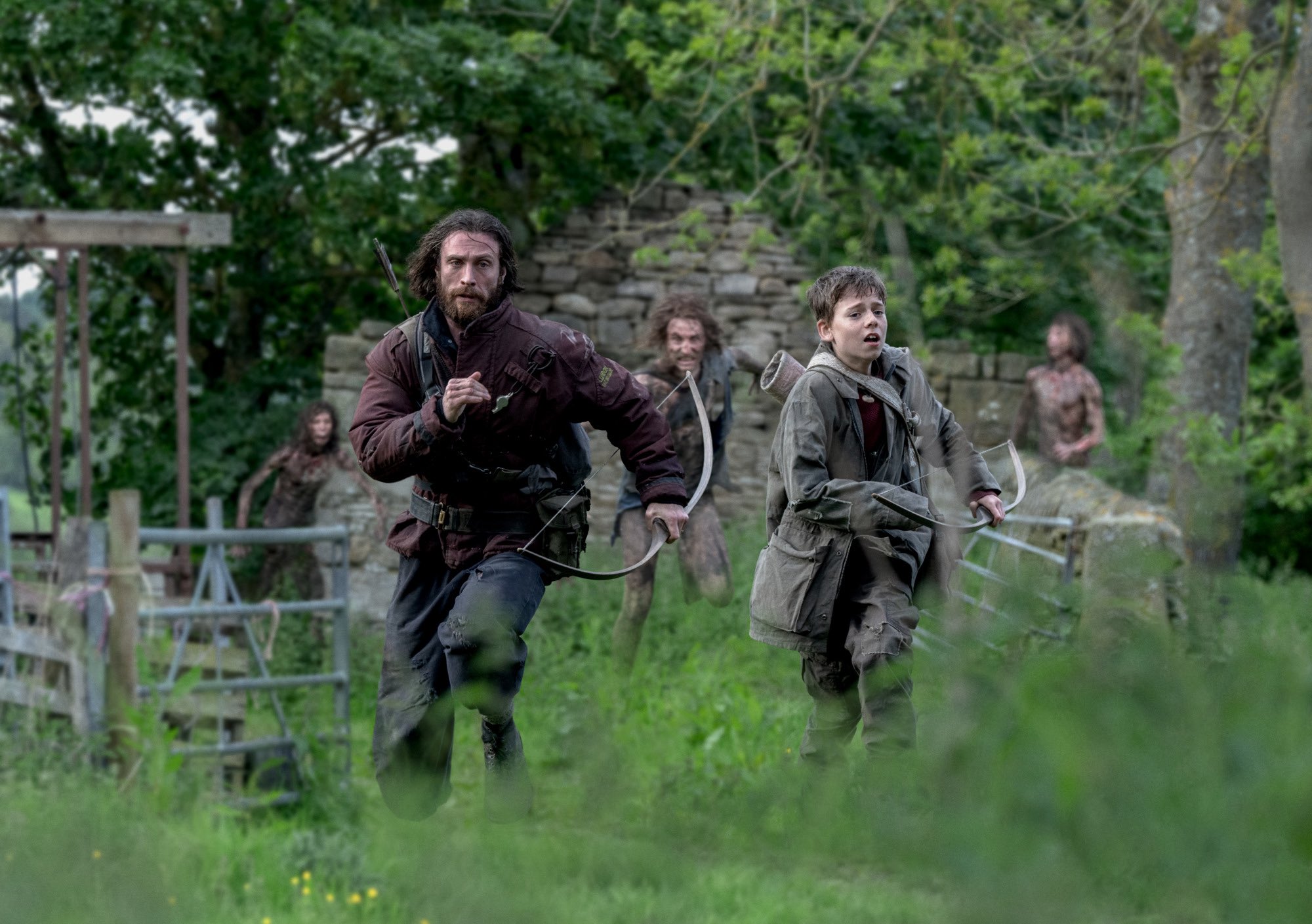28 YEARS LATER Review: Boyle and Garland Reunite to Deliver Timely Post-Apocalyptic Horror
Jodie Comer, Aaron Taylor-Johnson, Jack O'Connor, Alfie Williams, and Ralph Fiennes star.

Traditionalists prefer Romero. Unsurprisingly, Modernists prefer Garland-Boyle. Alternatively, Unitarians prefer not to choose at all, seeing value in both traditional and modernist approaches to an ever-changing genre.
Whatever school or group genre fans prefer, there’s no doubt writer Alex Garland (Civil War, Annihilation, Ex Machina) and director Danny Boyle's (Slumdog Millionaire, Sunshine, Trainspotting) 2002 (2003 in the U.S.) lo-fi post-apocalyptic horror thriller, 28 Days Later, radically rewrote the roles of the zombie sub-genre, a positive development for some (the aforementioned modernists) and an unhappy one for others (the aforementioned modernists).
No longer the slow-moving, shambling, flesh-eating corpses graphically imagined by Romero and company in Night of the Living Dead more than half a century ago, Garland and future Oscar winner Boyle’s “zombies” (loosely defined) turned into ferociously feral aggressors, infected by a brain-altering, blood borne disease, the so-called “Rage Virus,” driven by a unilateral desire to spread the disease to the non-infected. Spreading almost instantaneously, the spread of the virus across the world pandemic-style seemed inevitable, if not outright confirmed by the first direct sequel, 28 Weeks Later, released in the spring of 2007.
More than two decades later, 28 Years Later retracts the spread of the Rage Virus outside UK's island borders, dispensing with the spread to continental Europe via a single sentence projected on a black background. Instead, the UK found itself isolated from the outside world, permanently quarantined, cruelly forced to fend for itself without help of any kind. The Infected spread, but the survivors, small and dwindling in number, held, including the island sanctuary off the coast of Northern England at the center of 28 Years Later.
With only a narrow causeway, fully flooded at high tide, separating them from the mainland and its dangers, the island community has reverted to pre-technological, subsistence living (e.g., farming, livestock, fishing), sharing everything communally. That pre-technological, communal living has also led to the re-adoption of pre-20th-century folkways, including a not uncommon coming-of-age/rite-of-passage for the island’s teens, a potentially fatal day-trip to the mainland to hunt and kill the Infected with bows and arrows, that propels the first, undeniably engrossing section of Garland and Boyle’s collaboration.
Setting aside a traditional three-act structure, Garland and Boyle divide 28 Years Later into three linked sections or episodes, the first driven by nerve-shredding tension and suspense as Jamie (Aaron Taylor-Johnson), a thirty-something hunter, takes his 12-year-old son, Spike (a standout Alfie Williams), on his first hunt on the mainland. Filled with the expected, encounters with the familiar, fast-moving Infected, and the unexpected, a recently evolved subtype closer in conception to Romero’s original zombies, and something else altogether, the first section delivers on even the most extravagantly unrealistic expectations, specifically an extended fight-or-flight sequence executed to perfection by Boyle, the cinematographer, Anthony Dod Mantle, and the editor, Jon Harris, with unsettling, eerie sonic contributions courtesy of the score from the Young Fathers's and the sound design team.
Later sections involve Spike, essentially our point-of-view character for the audience, his mother, Isla (Jodie Comer), the latter’s undiagnosed, potentially terminal illness, and the lone survivor of a NATO patrol boat, E. Sundqvist (Edvin Ryding), and later still, a onetime physician-turned-philosopher, Dr. Kelson (Ralph Fiennes). The second section follows a more conventional, action-oriented through-line while the third and last turns surprisingly introspective as Kelson, long viewed by the island’s inhabitants as a madman, becomes both temporary tutor and mentor to young Spike: Living is hard in a post-apocalyptic, Infected-filled world, but so is dying and the finality of death.
Relying on relatively state-of-the-art digital tech (Apple iPhones rather than generic mini-DV cameras Doyle used to disorienting effect two decades ago), Doyle upgrades the original’s deliberately anti-beautiful sheen while retaining its hyperreal feel and tone. In an effort to add additional thematic heft to 28 Years Later beyond the usual post-apocalyptic ideas (rebuilding after the collapse of society, xenophobia/anti-outsiderism, the inevitable clash between selfishness and altruism), Boyle splices in archival footage of territorial wars for land, resources, and/or pride, suggesting that the conflict between the survivors and the Infected isn’t new. It’s just another chapter in a never-ending book about the circular rise and fall of humanity and its offshoots.
Anchored by uniformly strong turns from a cast perfectly in tune with Garland’s lyrically terse script, 28 Years Later only feels like a typical Hollywood sequel when the obligatory epilogue, tied to an initially disconnected prologue, comes into play. Presumably needed to connect 28 Years Later with the already-in-production sequel, 28 Years Later: The Bone Temple (a third film depends on box-office returns), it adds nothing essential to 28 Years Later.
But that’s a small misstep, presumably driven by commercial and not artistic concerns, for a film that otherwise delivers on everything audiences have come to expect from the first and second, under-appreciated entries in the series. 28 Years Later offers a window into a post-apocalyptic world that uncomfortably resembles our own and our all-too-human, deeply flawed responses to a global pandemic and the reflexive violence and tribalism that inevitably follow.
28 Years Later opens Friday, June 20, only in movie theaters, via Sony Pictures Releasing. Visit the film's official site for locations and showtimes.
28 Years Later
Director(s)
- Danny Boyle
Writer(s)
- Danny Boyle
- Alex Garland
Cast
- Jack O'Connell
- Aaron Taylor-Johnson
- Ralph Fiennes


Do you feel this content is inappropriate or infringes upon your rights? Click here to report it, or see our DMCA policy.







